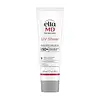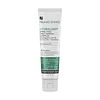What's inside
What's inside
 Key Ingredients
Key Ingredients

 Benefits
Benefits

 Concerns
Concerns

 Ingredients Side-by-side
Ingredients Side-by-side

Octocrylene 10%
UV AbsorberZinc Oxide 15%
Cosmetic ColorantWater
Skin ConditioningButyloctyl Salicylate
Skin ConditioningCoco-Caprylate/Caprate
EmollientIsohexadecane
EmollientButylene Glycol
HumectantIsododecane
EmollientPhenoxyethanol
PreservativePolyhydroxystearic Acid
EmulsifyingTriethoxycaprylylsilane
Polyacrylate Crosspolymer-6
Emulsion StabilisingAcacia Senegal Gum
MaskingPolysilicone-11
Xanthan Gum
EmulsifyingTetrahexyldecyl Ascorbate
AntioxidantEthylhexylglycerin
Skin ConditioningHydroxyethyl Acrylate/Sodium Acryloyldimethyl Taurate Copolymer
Emulsion StabilisingSqualane
EmollientDisodium EDTA
Polysorbate 60
EmulsifyingSodium Hyaluronate
HumectantSorbitan Isostearate
EmulsifyingOctocrylene 10%, Zinc Oxide 15%, Water, Butyloctyl Salicylate, Coco-Caprylate/Caprate, Isohexadecane, Butylene Glycol, Isododecane, Phenoxyethanol, Polyhydroxystearic Acid, Triethoxycaprylylsilane, Polyacrylate Crosspolymer-6, Acacia Senegal Gum, Polysilicone-11, Xanthan Gum, Tetrahexyldecyl Ascorbate, Ethylhexylglycerin, Hydroxyethyl Acrylate/Sodium Acryloyldimethyl Taurate Copolymer, Squalane, Disodium EDTA, Polysorbate 60, Sodium Hyaluronate, Sorbitan Isostearate
Zinc Oxide 6%
Cosmetic ColorantTitanium Dioxide 2.32%
Cosmetic ColorantWater
Skin ConditioningEthylhexyl Palmitate
EmollientCyclomethicone
EmollientDimethicone
EmollientPolysorbate 80
EmulsifyingCaprylyl Methicone
Skin ConditioningGlyceryl Stearate
EmollientPEG-100 Stearate
C12-15 Alkyl Benzoate
AntimicrobialSodium Acrylate/Sodium Acryloyldimethyl Taurate Copolymer
Emulsion StabilisingIsohexadecane
EmollientCetyl Alcohol
EmollientPropylene Glycol
HumectantPolyglyceryl-6 Isostearate
EmulsifyingCamellia Sinensis Leaf Extract
AntimicrobialGlycyrrhiza Glabra Root Extract
BleachingChamomilla Recutita Flower Extract
MaskingAlgae Extract
EmollientAloe Barbadensis Leaf Juice
Skin ConditioningAllantoin
Skin ConditioningGlycerin
HumectantPanthenol
Skin ConditioningButylene Glycol
HumectantCaprylyl Glycol
EmollientAlumina
AbrasiveLauryl PEG-9 Polydimethylsiloxyethyl Dimethicone
Skin ConditioningPolyhydroxystearic Acid
EmulsifyingTriethoxysilylethyl Polydimethylsiloxyethyl Hexyl Dimethicone
Skin ConditioningDiethylhexyl Carbonate
EmollientTriethoxycaprylylsilane
Disodium EDTA
Chlorphenesin
AntimicrobialPhenoxyethanol
PreservativeZinc Oxide 6%, Titanium Dioxide 2.32%, Water, Ethylhexyl Palmitate, Cyclomethicone, Dimethicone, Polysorbate 80, Caprylyl Methicone, Glyceryl Stearate, PEG-100 Stearate, C12-15 Alkyl Benzoate, Sodium Acrylate/Sodium Acryloyldimethyl Taurate Copolymer, Isohexadecane, Cetyl Alcohol, Propylene Glycol, Polyglyceryl-6 Isostearate, Camellia Sinensis Leaf Extract, Glycyrrhiza Glabra Root Extract, Chamomilla Recutita Flower Extract, Algae Extract, Aloe Barbadensis Leaf Juice, Allantoin, Glycerin, Panthenol, Butylene Glycol, Caprylyl Glycol, Alumina, Lauryl PEG-9 Polydimethylsiloxyethyl Dimethicone, Polyhydroxystearic Acid, Triethoxysilylethyl Polydimethylsiloxyethyl Hexyl Dimethicone, Diethylhexyl Carbonate, Triethoxycaprylylsilane, Disodium EDTA, Chlorphenesin, Phenoxyethanol
 Reviews
Reviews

Ingredients Explained
These ingredients are found in both products.
Ingredients higher up in an ingredient list are typically present in a larger amount.
Butylene Glycol (or BG) is used within cosmetic products for a few different reasons:
Overall, Butylene Glycol is a safe and well-rounded ingredient that works well with other ingredients.
Though this ingredient works well with most skin types, some people with sensitive skin may experience a reaction such as allergic rashes, closed comedones, or itchiness.
Learn more about Butylene GlycolDisodium EDTA plays a role in making products more stable by aiding other preservatives.
It is a chelating agent, meaning it neutralizes metal ions that may be found in a product.
Disodium EDTA is a salt of edetic acid and is found to be safe in cosmetic ingredients.
Learn more about Disodium EDTAIsohexadecane is added to enhance texture, emulsify, and to help cleanse. It is an isoparrafin. It is a component of petrolatum.
Due to its large size, Isohexadecane is not absorbed by the skin. Instead, it sits on top and acts as an emollient. Emollients help keep your skin soft and smooth by trapping moisture within.
Isohexadecane is often used in products designed to help oily skin. It is lightweight and non-greasy while helping to moisturize. When mixed with silicones, it gives a product a silky feel.
Learn more about IsohexadecanePhenoxyethanol is a preservative that has germicide, antimicrobial, and aromatic properties. Studies show that phenoxyethanol can prevent microbial growth. By itself, it has a scent that is similar to that of a rose.
It's often used in formulations along with Caprylyl Glycol to preserve the shelf life of products.
Polyhydroxystearic Acid is a soft wax made from castor oil.
It is is a texture thickener, emulsifier, and film-former. Emulsifiers prevent ingredients from separating, such as oils and waters.
Polyhydroxystearic Acid may not be fungal acne safe.
Learn more about Polyhydroxystearic AcidTriethoxycaprylylsilane is a silicone used to bind and stabilize ingredients.
As an emulsifier, it helps prevent ingredients from separating. This can help elongate the shelf life of products.
Triethoxycaprylylsilane is often used to coat mineral sunscreens ingredients to help give a better feel. It also helps reduce oxidative stress in sunscreens.
Learn more about TriethoxycaprylylsilaneWater. It's the most common cosmetic ingredient of all. You'll usually see it at the top of ingredient lists, meaning that it makes up the largest part of the product.
So why is it so popular? Water most often acts as a solvent - this means that it helps dissolve other ingredients into the formulation.
You'll also recognize water as that liquid we all need to stay alive. If you see this, drink a glass of water. Stay hydrated!
Learn more about WaterZinc Oxide is a mineral broad-spectrum UV filter; it is the broadest UVA and UVB reflector approved by the FDA. It also has skin protectant and skin soothing properties.
Zinc oxide is one of the most effective broad-spectrum UV filters. It protects against UVB, UVAII, and UVAI. In comparison to its counterpart titanium dioxide, zinc oxide provides uniform and extended UVA protection.
Another great benefit? This ingredient is highly photostable so it won't degrade easily under sunlight.
A common myth is that mineral UV filters are widely believed to primarily reflect UV light.
However, modern research shows titanium dioxide absorbs UV radiation like chemical filters (~95% absorption & 5% reflection).
Zinc oxide has great skin soothing properties so you'll likely find this in sunscreens formulated for sensitive skin or babies/children. It is unlikely to cause "eye sting" like other sunscreen ingredients.
Regulatory agencies consider zinc oxide to be non-toxic and safe. It has also been shown to not penetrate the skin.
Unfortunately, this ingredient does leave a visible white cast. This is why mineral sunscreens are often less cosmetically elegant than chemical or hybrid ones.
In cosmetics, zinc oxide can be found in both non-nano and nano-sized forms. The nano version is used to reduce white cast and improve the texture of sunscreen formulas.
There are ongoing concerns surrounding nano-zinc oxide's impact on marine ecosystems and whether it can be absorbed into skin.
Regarding marine ecosystems and coral reefs, there is no conclusive evidence that any form of zinc oxide (or any other sunscreen ingredients) will cause harm. The science is still developing but many consumers are keeping a close eye on this issue.
Please note, many destinations have reef-safety sunscreen rules. For instance, the U.S. Virgin Islands advises all visitors to use non-nano mineral sunscreens.
There has also been some stir about whether micronized or nano zinc oxide has potential photoxicity and absorption through the skin/lungs.
An in-vitro (done in a test tube or petri dish) study demonstrated micronized zinc oxide to have potential phototoxicity. There's no need to fret; the EU Commission's Scientific Committee on Consumer Safety has stated, "The relevance of these findings needs to be clarified by appropriate investigations in vivo." Or in other words, further studies done on living organisms are needed to prove this.
Current research shows zinc oxide nanoparticles do not penetrate intact or sunburned skin. They either remain on the surface or in the outermost layer of dead skin (stratum corneum).
Zinc oxide is one of only two classified mineral UV filters with titanium dioxide being the other one.
Fun fact: Zinc has been used throughout history as an ingredient in paint and medicine. An Indian text from 500BC is believed to list zinc oxide as a salve for open wound. The Ancient Greek physician Dioscorides has also mentioned the use of zinc as an ointment in 1AD.
Learn more about Zinc Oxide